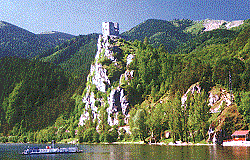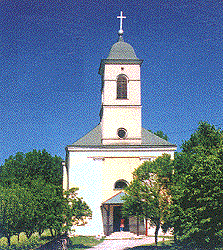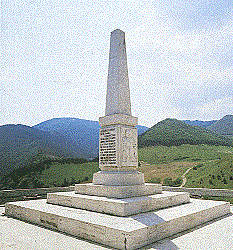 The village of Strečno is situated at the diving line of the Turčianska a Žilinská Basin
in the area of the flow the river Váh through the range of mountains called the Malá
Fatra. The beautiful scenery together with the two neighbouring castles provide an
exceptional landscape within the territory of Slovakia.
The village of Strečno is situated at the diving line of the Turčianska a Žilinská Basin
in the area of the flow the river Váh through the range of mountains called the Malá
Fatra. The beautiful scenery together with the two neighbouring castles provide an
exceptional landscape within the territory of Slovakia.
The village is situated in the altitude of 360 meters and the first written record comes
from 1321 since there was a toolbooth there. Traces of the existence of the man were
found here, going back to the beginning of our era, there was a Slavic settlement here
in the 9th century and till 1848 Strečno formed an integral part of the estate of the
Strečno Castle, one part of the village belonged to the yeoman families of the Hranostajs
and the Račajs.

|
|
Castle of Strečno
|
In addition to agriculture and woodprocessing, the inhabitants were engaged in
raftsmanship and fishing, the proof of this is the town´s seal containing a swimming
fish. We can find descriptions of the river Váh in the area of Strečno in the works
of well-known Slovak writers such as Ján Botto - in his tragic ballad called Margita
Besná, also in the work of Ladislav Medňanský - Malebná cesta dole Váhom - The
picturesque Voyage Down the Váh and in others.
Points of interest, remarkables and rarities

In the 16th - 17th centuries the numbers of the population was about 400, in 1784 536
people lived in 76 houses. The population of Strečno had the following numbers:
in 1828-731, in 1900-717, in1921-758, in 1940-1149, in 1961-1716 and at present
2300 people.
The small settlement called Zlatné formed an integral part of Strečno since the Middle
Ages. The Roman Catholic church was built in the first half of the 19th century and
was consecrated to St. Sophia, the Roman widow.

|
|
Roman-Catholc church
|
Since the beginning of the 20th century most of the population has been working in
different industries in the vicinity of the city Žilina but also as railway workers
in Vrútky, in the quarry of Stráňavy and a nearby mine extracting rocks containing
asphalt, which is the only one of its kind in Slovakia. Rocks were extracted also on the
hill of the Castle in 1909-1919.
A punt across the river Váh started working in 1923. In the period from 31st august to
3rd September 1944, there were fierce battles between the patriot partisans of the
Slovak National Uprising and the units of the German army attacking them from Žilina,
the battles took place in the straits of Strečno.
In addition to the Slovak and Soviet partisans, also 155 Frenchmen under the command of
Captain Georges de Lannurien took part in the battles. In 1956 a monument was unveiled
in their honour on the hill of Zvonica.

|
|
Monument
|
The village of Strečno is well-known first of all thanks to the castle of the same name,
which is a national cultural monument. The first written mention of it occurred in 1316,
though the castle existed in the 13th century. Its first owners were the Balašes, later
Matúš Čák Trenčiansky, the Deršfy family, the Pongráces, the Vešelenis, and the Esterhazy
family and other aristocratic houses and sovereigns.
The oldest part of the castle is represented by the four-storey tower of a prism form,
to which a Gothic palace with a chapel were added in the 14th - 15th centuries.
In the 16th century, a new Renaissance part of the castle was built. In the 17th
century, the castle started to become desolate and the last reconstruction work
was carried out in the period of 1655-1657. The castle as the property of František
Vešeleni, the leader of the anti-Habsburg conspiracy, was destroyed by the emperor´s
army in 1674.
The castle had a mill on the Váh under the castle and there was one more on the estate
belonging to the castle. Under the castle there was a landing place for the rafts, a
building where gunpowder was produced and also a toolbooth whose remainders have been
preserved up to these days.
The wife of František Vešeleni, Žofia Bošniaková (1609-1644) lived in the castle since
1930. Due to her very good character, willingness to help the poor and suffering
people and her charity, she was very popular and so her reputation is still alive
among the population up to now. After her death 28th April 1644, she was buried in
the crypt under the castle´s chapel. During the inspection of the ruins of the castle
in 1689, her coffin was discovered in which her body was almost inviolated and in a
very good condition. In 1698, she was transferred to the village of Teplička, where
she can be found in the Roman Catholic church up to now.
The villages of Strečno and its castle are very attractive spots for tourists from the
whole territory of Slovakia and from abroad. We wish them a very pleasant stay during
their learning our history and getting acquainted with the beautiful spots of our village.
Translation: Hošková